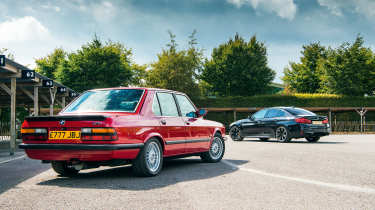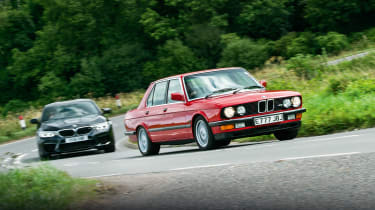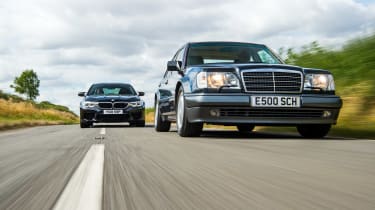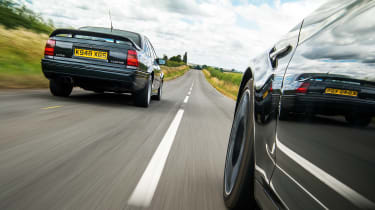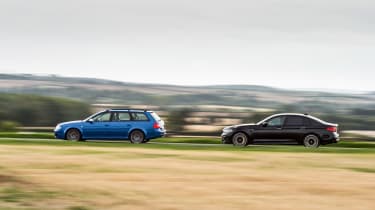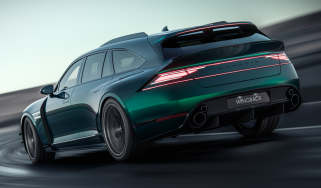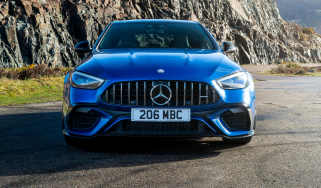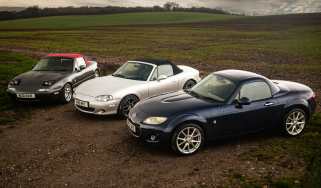BMW M5 F90 vs E28 M5, RS6, E500 and Lotus Carlton: supersaloons old vs new
From the first to the very latest, we take a dive into the history of the supersaloon with the 1985 BMW M5 E28 and other classics taking on today's model
Who, specifically, produced the first supersaloon is inevitably a subject of much debate, but the general consensus in the evo office is that BMW’s E28 M5 of 1985 was the first true-blue, manufacturer-produced supersaloon. American hot-rodders may have got there way before by slotting heinously powerful engines into otherwise humble ‘sedans’ since the ’50s, and Jaguar too, with the blagger’s favourite the Mark 2, but for evo the family tree starts with BMW.
During the 34 years since, the genre has never looked back when it’s been time to roll the dice once more. Yet while BMW M-badged 5-series cars may no longer be hand-assembled in their own factory, the principles are very much the same. With each passing decade the M5 has become more powerful, naturally faster and far more sophisticated, with ever-increasing levels of technical complexity introduced with each generation to make it better, some say, and easier to drive. Safer too, despite the output of the average modern-day supersaloon being more than double that of the 282bhp BMW’s Motorsport department extracted from the E28’s M88 straight-six.
The E28 of 1985 is a very different machine to that of today’s F90, but how did we get from yesterday’s original to the now? And who has steered the course of progress along the way?
> New BMW M5 review – is 4WD and 592bhp enough to raise the super-saloon bar?
To arrive at the beginning we need something from today to get us there: an F90 M5. Arriving at our first stop in the paddock of Goodwood circuit, there’s a proud Tim Maltby beaming back at us from behind the wheel of his E28. Maltby has owned his Henna Red example for nearly 15 years and it’s done close to 200,000 miles. But during that time he’s spent reasonably big money getting it into a condition that’s not quite concours, perhaps, but pretty damn tidy all the same.
The first thought that occurs to me is just how petite it appears. I remember seeing my first E28 M5 new in late ’85, and thinking how big and aggressive it looked, how defining its BBS multi-spoke16-inch wheels and tyres appeared (European-spec cars had metric wheels and tyres fitted). Even the lip spoiler on the bootlid looked OTT. Today, though, the E28 fits in the F90’s shadow, a car that’s larger in every proportion you care to mention – its wheels are five inches bigger in diameter.
In 1985 the E28 M5 was declared by BMW to be ‘the fastest production saloon in the world’, not that this resulted in a flood of orders, with just over 2000 built during the car’s three-year production run. This 1987 example is one of the original UK-supplied cars and the results of Tim’s investment of time and money are clear to see – it’s a beautiful example of a classic car that is cared for and used, with only a slightly fruitier-than-normal exhaust system to prevent it from being absolutely as it was the day it rolled out of the factory in Garching, Germany.
The inside feels and looks just as yesteryear as the outside, with right angles and hard surfaces and very little in the way of auxiliary controls. And it feels just as small in here as it appears from the outside.
When you fire the 3.5-litre six into life the E28 does a little shimmy as the whole car wakes up, and there are further traits that age it too. The accelerator is quite stiff as your foot pushes against its cable operation, ditto the clutch, and the five-speed Getrag gearbox isn’t ashamed of its long throw. On the move the car feels antiquated, of course it does, in that its ride is firm but lacks a bit of control, while there is the occasional creak from the seat over bumps and the noise refinement is from a time when sound insulation was a cursory consideration. But there’s a raw and rich sense of charm, a pure connection through the steering and all four corners that today’s cars of this classification are almost entirely devoid of. It’s easy to knock new cars and reminisce about the past, but in this instance I’m comfortable in justifying the enjoyment to be had from behind the wheel of an E28 – because there is a point in owning and just driving a car like the E28, because it is completely different from any contemporary car today. Including the latest M5, or any current supersaloon for that matter.
True, the E28’s performance seems somewhat undercooked by today’s standards (it’s Golf GTI quick in a straight line), even when you enjoy that BMW ‘six’ sweep through third and fourth gears delivering its hardest punch. And no, the transmission isn’t the quickest, the suspension lacks the detail garnered over the last 30-plus years and the steering feels precise if not very sophisticated. But there’s also a feeling of interaction to the E28 that reminds me why cars such as this were so revered when we first drove them. They drove nothing like the regular model they were based on. They felt what they were at the time: truly bespoke.
An E28 M5 also feels about half the size of today’s breed. Again, lessons could and should be learnt from this given that modern cars too often feel too big for many of the UK’s more minor (read: interesting) roads.
> Alfa Romeo Giulia Quadrifoglio review - a truly great super saloon
With the sound of the M88 still providing a welcome soundtrack to the day, we bid Maltby’s E28 farewell and point the F90’s 592bhp twin-turbo’d V8 north towards Rutland, where it has an appointment with a very special and exceptionally lovely Mercedes E500. In the meantime, the 200-mile trek from the south coast to the Midlands allows for some thoughts on today’s M5. In no particular order these are: One, how big, sophisticated and luxurious it feels, especially inside. Two, how quiet it is on the move. Three, how stiff the ride feels compared to the old-timer, even with the dampers set to Comfort. But most of all, four, just how damn fast it is, not only by comparison to the E28 – that’s a given – but in terms of being a near two-ton, four-door car with plenty of room for five and luggage on board.
Then there is how effortlessly the eight-speed ZF ’box picks off ratios as you squeeze the accelerator anywhere near to the floor. Even at half-throttle the F90 is seriously quick in second, third, fourth or fifth gear – it doesn’t really matter which because it just goes. Maybe there is half a second of lag from the moment you touch the fly-by-wire throttle to the turbos spooling and delivering a tsunami of torque. Then you give it the lot, and on the road, with the engine and transmission maps set to Sport+, to be honest it almost feels too potent, possibly even too fast for its own good. As a result you need to hang on tight, both physically and mentally, to keep up. Go beyond maximum attack for more than a couple of seconds and you will be travelling at way the other side of three figures. And this is where you feel today’s supersaloons have picked up the goal posts and deposited them in another country. The delicacy of the original M5 has been replaced with the performance of a 997 Turbo.
Impressive as this is from an engineering point of view, it does mean that driving today’s crop of supersaloons is actually an act of deep self-restraint. You take your enjoyment of their outright capabilities on the road in very short bursts, and those bursts need to be experienced to appreciate the nature of the performance, even if the noise produced by the F90 is a touch ordinary and its steering too much of a digital experience.
Inevitably you spend more time on motorways than you do thundering across B-roads in today’s supersaloons. That’s just the way of modern travel. In this respect, however, I’m not convinced this generation of M5, or any of today’s supersaloons for that matter, is as good as it could be. It does the fast and refined elements expected of its ilk with consummate ease, and it’s certainly not lacking in technology (much of it adding little to the driving experience, it has to be said). It’s the feeling of specialness, or lack thereof, that I’m not so convinced about. In the E28, and the others we’re sampling here, there are a number of features that mark each car out as something special. Exhaust and engine notes at tickover, instrument designs with unique markings, tactile materials covering core touch points. It’s these things and a handful more that identify these cars as special, a step up from the normal machines they are built upon. At times the F90 M5 feels and looks no different to a 540i. The supersaloon’s bespoke nature has been replaced with a ubiquitous aesthetic.
The sight of Simon Harrison and his Mercedes E500 is a welcome one and I’m ready to climb out of the F90. It doesn’t take long in the Merc to work out why. No, the old 5-litre V8 W124 from 1991, whose chassis was tweaked by Porsche (it assembled the car too), doesn’t feel as bombastic or obviously rapid or exciting as a modern-day counterpart, despite sharing the same cylinder count. Neither does it feel as precise as the E28 did, but what it does do quite beautifully is breathe with the road surface. It flows with a quite astonishing level of grace and composure, not just for a 25-year-old car but for any car. It makes the F90 feel neurotic by comparison in this respect. And in isolation it goes pretty well, too, much harder than I was expecting, even if its auto ’box is quite lazy and deeply old school in its operation. It’s a very different approach to a supersaloon than Mercedes’ offerings today.
It also steers amazingly well. I drove this car when it was brand new and Harrison’s example feels equally fresh. Then again, he’s spent a small fortune to ensure it is basically just that, and it shows. The E500 is a very different prospect to the E28 M5. Where the M-car was born with motorsport DNA, the E500 (or 500E as it was called in pre-facelift guise, though this is a later car) has the feeling of a car finely tuned to deliver a more rounded performance for those wishing to travel under the radar when commuting between Cologne and Frankfurt at speeds more akin to its assembler’s contemporary sports cars. It was a car that those who knew knew, while others dismissed it as a vehicle they were more accustomed to seeing at an airport with a yellow light on its roof. Which is fine by me, because a supersaloon should always be about subtle performance.
The E500’s 5-litre V8 was taken from the SL and produced 321bhp and 354lb ft, its four-speed auto accounting for the tardy 6.8sec 0-62mph time, but it was good for 156mph and could sit at 150mph for mile on end. Much of this was down to the re-engineering Porsche did to the W124’s chassis. It was a different take on supersaloon formula to the M5 – which by 1991 was in E34 guise – but of all the cars I’ll drive for this story, this is the one I’ll most want to take home and keep. Which surprises me more than it possibly does you.
> Mercedes-AMG E63 review – BMW M5 rival is better than ever
Especially so as our next encounter is with possibly the baddest and maddest supersaloon of all: the Lotus Carlton. Desiring the E500 is quite a choice, because the BitchCarlt, as it was once named by the late, great Russell Bulgin, formerly of this parish, has long been one of my outright favourite cars. Maybe my memory is tainted because, as a junior road tester in 1990, the Lotus Carlton completely and utterly blew my mind. With 377bhp and a thundering 419lb ft, Ford’s Sierra Cosworth and the aforementioned 500E didn’t know which way it went, and it was so much more outrageous and extrovert in everything it did. It was, I thought at the time, a car that would never be bettered, certainly not in terms of pure performance. No, its cabin couldn’t hide its humble origins, and the build quality was never great, but just as the Mercedes benefitted from the hand of Porsche, the Carlton had been massaged by the hands of Lotus.
Yet beside today’s M5 the Lotus Carlton seems as nothing. It’s nowhere near as fast, or as imposing; it actually looks old school and just not very He-Man any more, even though the F90, to my eyes and many others at evo, is the least imposing and distinctive of all M5s. How times have changed. There’s still plenty of charm swimming around in the LC, though. The lag from the 3.6-litre twin-turbo straight-six needs working around, the six-speed ’box requires Popeye’s forearms and you’ll need Chris Hoy’s thighs for the clutch, but it’s worth every bead of sweat just to experience the performance hit of the car the Daily Mail wanted banned.
The Carlton’s chassis wasn’t a bad place for Lotus to start: in 3000 GSi guise it was a sweet operator, far more sophisticated – if less energetic – than the Sapphire Cosworth, and after it had left Hethel the big Vauxhall had lost none of its dynamic prowess, although it never felt dynamically proficient enough to match the herculean performance the chassis was now tasked with mastering.
Return to the F90 M5 after the Carlton and you can see what Lotus and Vauxhall were looking to achieve: big power, huge performance and off-the-scale aggression, but ultimately it was a decade too soon. This is confirmed when we meet our final car on this journey through the annals of the supersaloon: the Audi RS6.
Yes, it’s an Avant, because if you’re going to have an RS6 it surely has to be an Avant. This C5 RS6 lives with Audi’s heritage fleet and is therefore 100 per cent fighting fit. In many ways it still feels decently modern beside all the other cars from yesteryear, which it should do being a dozen years younger. It still goes well too, as it should with 444bhp from its twin-turbo 4.2-litre V8. However, what does age it is the clonky auto transmission and the brittle ride, which makes my earlier complaints regarding the M5’s sound churlish. Then again, the C5 RS6 never did ride very well. Or handle with any great precision. Even in 2002 it was a bit of a blunderbuss, albeit a very cool-looking one, and time has done it few favours on the dynamic front.
For many it remains a wholly desirable proposition, and quite rightly so, but the latest RS6 is a far better representation of what Audi Sport can achieve with an A6 estate and a mighty twin-turbo V8. Yet whilst a C5 lacks ultimate driving engagement it remains light years ahead of the big-engined, huge-powered SUVs that started to appear around the same time, and for that reason alone it should be applauded.
As should the ongoing cult following for supersaloons as a whole. We’ve never really needed a family four-door that can outrun a 911 and keep a McLaren in its sights, but the fact such cars have existed for so long and continue to occupy product planners’ strategies is something to be cherished, particularly in the now fully-fledged era of the high-performance SUV. Long may it continue.
| Audi RS6 Avant (C5) | Lotus Carlton | BMW M5 (E28) | Mercedes-Benz E500 (W124) | |
| Engine | V8, 4172cc, twin-turbo | In-line 6-cyl, 3615cc, twin-turbo | In-line 6-cyl, 3453cc | V8, 4973cc |
| Power | 444bhp @ 5700rpm | 377bhp @ 5200rpm | 282bhp @ 6500rpm | 321bhp @ 5700rpm |
| Torque | 413lb ft @ 1950-5600rpm | 419lb ft @ 4200rpm | 251lb ft @ 4500rpm | 354lb ft @ 3900rpm |
| Weight | 1865kg | 1658kg | 1431kg | 1710kg |
| Power-to-weight | 242bhp/ton | 231bhp/ton | 200bhp/ton | 191bhp/ton |
| 0-62mph | 4.6sec | 5.4sec | 6.1sec | 6.8sec |
| Top speed | 155mph (limited) | 177mph | 156mph | 156mph |
| Price when new | £58,800 | £48,000 | £31,295 | £57,000 |
| Value today | £12,000+ | £39,000+ | £35,000+ | £25,000+ |
This feature was first published in evo issue 258. To ensure you receive all upcoming issues, subscribe now!
